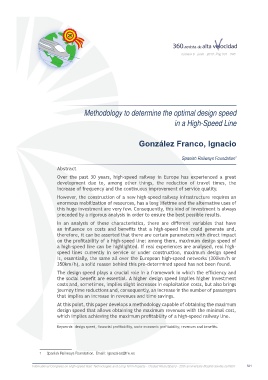Page 533 - 360.revista de Alta Velocidad - Nº 6
P. 533
25
número 6 - junio - 2018. Pág 531 - 548
Methodology to determine the optimal design speed
in a High-Speed Line
González Franco, Ignacio
Spanish Railways Foundation 1
Abstract
Over the past 30 years, high-speed railway in Europe has experienced a great
development due to, among other things, the reduction of travel times, the
increase of frequency and the continuous improvement of service quality.
However, the construction of a new high-speed railway infrastructure requires an
enormous mobilization of resources, has a long lifetime and the alternative uses of
this huge investment are very few. Consequently, this kind of investment is always
preceded by a rigorous analysis in order to ensure the best possible results.
In an analysis of these characteristics, there are different variables that have
an influence on costs and benefits that a high-speed line could generate and,
therefore, it can be asserted that there are certain parameters with direct impact
on the profitability of a high-speed line; among them, maximum design speed of
a high-speed line can be highlighted. If real experiences are analysed, real high-
speed lines currently in service or under construction, maximum design speed
is, essentially, the same all over the European high-speed networks (300km/h or
350km/h), a solid reason behind this pre-determined speed has not been found.
The design speed plays a crucial role in a framework in which the efficiency and
the social benefit are essential. A higher design speed implies higher investment
costs and, sometimes, implies slight increases in exploitation costs, but also brings
journey time reductions and, consequently, an increase in the number of passengers
that implies an increase in revenues and time savings.
At this point, this paper develops a methodology capable of obtaining the maximum
design speed that allows obtaining the maximum revenues with the minimal cost,
which implies achieving the maximum profitability of a high-speed railway line.
Keywords: design speed, financial profitability, socio-economic profitability, revenues and benefits.
1 Spanish Railways Foundation. Email: Igonzalez@ffe.es
International Congress on High-speed Rail: Technologies and Long Term Impacts - Ciudad Real (Spain) - 25th anniversary Madrid-Sevilla corridor 531

